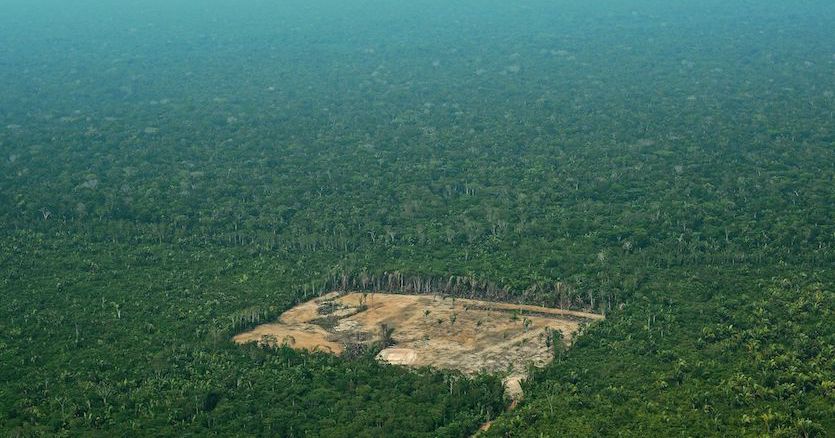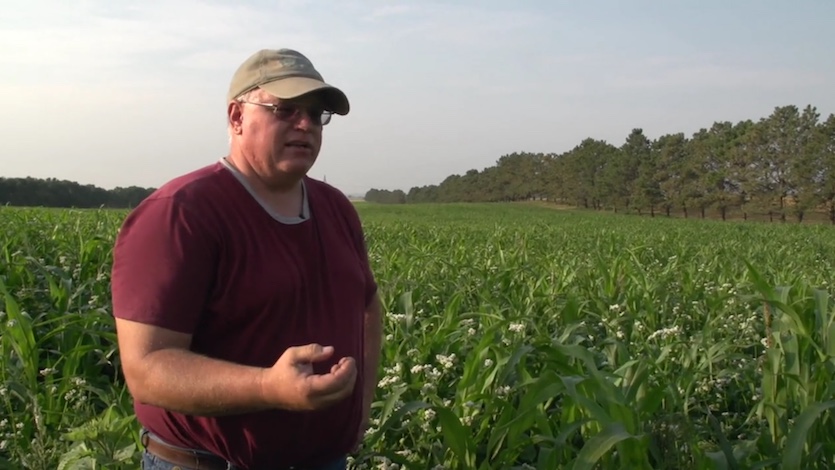We generally don’t think we can do much about the weather. Expert prediction and analysis, such as that from Weather Underground, help us prepare for storms, cold and hot spells, errant jet streams, and the like. But the weather seems to insist on having a will of its own.
On a local level, however, there’s much we can do to affect a number of weather factors—temperature, for example. Consider this suburban front yard pictured in Figure 1 below. The ambient temperature is 90°F. What do you think the difference in land-surface temperature is between the coolest (under the bushes) and warmest (asphalt) spots? The answer is at the end of this article.
 |
| Figure 1. Land surface makes a difference! Image credit: Courtesy Adam Sacks. |
What makes the temperature difference is water, shade, and ground cover. Nature’s rule is that healthy soils are never bare—asphalt is the equivalent of very bare soil, made worse by its low albedo, i.e., low reflectivity and increased heat absorption. Here’s one place where water comes in: it’s a great temperature buffer. It’s the lack of water that causes day-night temperature extremes in deserts, for example. With abundant and strategic use of soils, plants and biodiversity to capture and cycle water, local temperatures, including heat-island effects in cities, may be significantly moderated.
There is growing evidence that we humans may have far more control over the meteorology above our heads than we think. We can create weather more to our liking—and beneficial for our survival and that of many species—by paying attention to the soils, plants and other living creatures underfoot and all around us.
What do bacteria have to do with rainfall?
All life needs water, and all species, from microbes to megafauna, have worked out strategies for obtaining and cycling water to benefit themselves within the overall balance in their habitats. We thus find ourselves part of an extremely complex Earth water-balancing system, in large measure driven by living things, with virtually infinite reactions and variables. Fortunately, this system also has handles that we humans can grasp and paths we can shape for the benefit of biodiverse ecosystems which are ultimately necessary for our own well-being.
Rainfall is a vitally important weather process where humans have a significant role to play. In order for atmospheric water vapor to fall as rain or snow, it must condense around microscopic particles called condensation nuclei. That’s the idea of cloud seeding with silver iodide or other chemical agents, but the diverse ways nature does it are generally far safer and more effective, mostly using condensation nuclei emitted by plants. Those nuclei are comprised largely of biological particles and bacteria, which has opened up a rapidly growing research area called bioprecipitation. Scientists are taking a closer look at how plant-based nuclei make their way into precipitation and how we might influence that process.
Science writer Fred Pearce describes a fascinating, little-known piece of vintage research in a Yale360 article, “The Long, Strange Journey of Earth’s Traveling Microbes”:
"Back in 1979, Russell Schnell of the University of Colorado was in western Kenya wondering why the tea plantations there held the world record for hailstorms. They occurred 132 days a year. He discovered that tiny particles of dead and decaying leaves in the soil bore a close resemblance to the tiny particles around which hailstones formed. They were, it turned out, far better adapted to the task even than man-made cloud seeding chemicals like silver iodide. . . . [Schnell] concluded that 'the feet of hundreds of tea pickers going about their daily jobs' were to blame for the hail. By kicking the bits of leaf into the air, he said, the tea pickers must be providing the abundant ice-nucleators that created the hailstorms."
Which may lead us to conclude that traditional rain dances are a pretty good idea after all.
 |
| Figure 2. Aerial view of deforestation in the Western Amazon region of Brazil on September 22, 2017. Parts of the Western Amazon rainforest have suffered some of the region’s heaviest deforestation. Illegal logging has been difficult to control. Image credit: Carl De Souza/AFP/Getty Images. |
Rivers that fly through the rainforest
The concept of the biotic pump, developed over the last decade, is one example of large-scale movement of water driven by trees. According to this theory, the vapor pumped by trees into the atmosphere condenses and creates an area of slightly lower air pressure (since humid air at a given temperature and pressure weighs less than dry air). In turn, the lower pressure draws moisture inland from an abundant water source, primarily oceans.
In the Amazon, according to the biotic-pump theory, the forests themselves pull massive volumes of water, dubbed “flying rivers,” into the interior. Deforestation can hinder this movement of water: drought and fire have begun to afflict even a famously wet ecosystem. Scientist Antonio Nobre tells this remarkable Amazon climate story in his 2014 TED Talk, The magic of the Amazon: A river that flows invisibly all around us (also check out The Amazon Makes Its Own Wet Season, and Biotic Regulation).
Science is beginning to understand what many indigenous cultures have long known: that it is within our power to reverse ecological destruction and play a positive role in climate and weather.
Protecting farms and ranches by paying attention to the soil
On a practical level, Gabe Brown’s ranch in Bismarck, North Dakota, is an example of how people can transform the land, the food supply, economics and their own lives by following nature’s lead. Over a period of around twenty years, motivated by four years of drought and crop disasters, Brown transformed his farming practices by focusing on soil health, and the elimination of synthetic amendments which disturb vital balance in a grassland/cropland ecosystem. He is one leader among a new breed of farmers whose work is transforming the quality and sustainability of the food we grow.
The result is a vibrant food-production ecosystem that today can absorb over eight inches of rainfall per hour on the one hand (compared to only a half-inch per hour in 1991) and remain healthy and productive even in drought conditions on the other. “Soil Carbon Cowboys” is an excellent 12-minute video that tells the stories of three ranchers, including Gabe, and the approaches to land management that changed their lives as well as the ecosystems around them.
 |
| Figure 3. Gabe Brown describes his efforts to increase carbon stocks in the soil at his farm in central North Dakota. Image credit: “Soil Carbon Cowboys”, courtesy Peter Byck, carbonnation.tv |
A study published in the journal Agriculture, Ecosystems & Environment in 2016, “The surface-atmosphere exchange of carbon dioxide, water, and sensible heat across a dryland wheat-fallow rotation,” illustrates how changing one practice—stopping summer fallow (keeping a field out of production during the growing season)—can lead to notable changes in weather as well as increased capture of atmospheric carbon in soils. The use of summer fallow, which was originally instituted to conserve water, has decreased by tens of millions of acres in the North American Great Plains since the 1970s. Farmers across the area began to realize over the years that while there was some water conservation with summer fallow, there were even more significant economic and soil conservation benefits without it. Results have been dramatic:
“The widespread decline of fallow in agricultural areas of the Canadian Prairie Provinces has coincided with a summer-time cooling trend since the 1970s. Extreme temperature events now occur less frequently than in the recent past, maximum summer temperatures have decreased by [around] 2°C, relative humidity has increased by some 7%, and summer precipitation has increased by an average of 10 mm/decade across parts of the Canadian Prairie Provinces. A remarkable 6 W/m2 summer cooling has been observed; for reference, anthropogenic greenhouse gases are responsible for [roughly] 2.5 W/m2 warming globally since the dawn of the Industrial Era. These climate benefits have only occurred during the growing season; fall, winter, and early spring temperatures have followed global trends.
“Studies suggest that these climate changes are the result of land management, specifically the trend away from leaving fields fallow during summer. These large-scale declines in fallow area have resulted in less sensible heat and more water vapor entering the atmosphere and a moister, shallower atmospheric boundary layer (ABL) and lower lifted condensation level (LCL) with an increased probability of convective precipitation. In other words, the observed regional climate cooling is broadly consistent with the effects of fallow avoidance on climate processes [pp. 130-131; references omitted].”
Based at Montana State University, this research group has found similar cooling effects across parts of the northern Great Plains, another region where summer fallow has been reduced and no-till agriculture has been increased. A related poster was presented at the American Meteorological Society’s annual meeting in Austin this month.
A river runs through it—once again
Riparian zones (the areas around creeks and rivers) are the lifelines of arid and semiarid regions, and often corridors of great biologic diversity. Recovery of the riparian zone (sedges, rushes, willows) is the first step in restoring floodplain function. Riparian areas can and do respond to changes in grazing in just one or two growing seasons where the water table is available to the riparian plants, even in areas with as little as 9 inches of annual precipitation.
In northeast Nevada, an old, broadened-out gully called Susie Creek (see figure below) changed dramatically within the first few years following the change in grazing management. About 15 years into the project, beavers showed up on their own, making a major contribution with their water engineering skills. Even after a four-year drought (2012–2015) in which other ranchers were having to truck in water, the Susie Creek area still had perennial ponds and streams.
This work was a collaboration among many participants, including federal and state agencies and Maggie Creek Ranch, led by fisheries biologist Carol Evans—who wanted to bring the Lahontan Cutthroat Trout back to Susie Creek—and rancher Jon Griggs, who wanted grass and water for his herd. (See video of Carol and Jon telling their story here.) If we can do this in Nevada, we should be able to do it just about anywhere!
 |
| Figure 4. Restoring floodplain function: Susie Creek in Elko in northeastern Nevada on Sept. 25, 1989 (left) and Sept. 11, 2015 (right). Nevada is the driest state in the U.S., with less than 10” of annual rainfall. The 2015 photo was taken at the end of one of the region’s worst four-year droughts on record. The improvements in the condition of the land shown here are largely due to regenerative managed grazing. Ruminants, including cattle, are keystone species on rangelands. When herded the way nature does it, the grazing ruminants bring water and rich biodiversity back to the land. Image credits: Carol Evans, Elko District, Bureau of Land Management. |
These are just a few examples of how better caring for the land that we humans use can make major differences in many factors affecting the biosphere and the weather. A project that I founded with four colleagues, Biodiversity for a Livable Climate, has held ten conferences over the past three years, bringing together scientists and land managers from five continents. They have explained many instances of regenerative management that can return abundance to billions of desertified acres across the planet. (All conference videos are available for viewing on our website.)
While mainstream science is only recently catching up with effective practice, we already know a good deal about how to reduce weather disasters and climate warming, while restoring soils and biodiversity, increasing agricultural productivity, and building environmentally resilient and economically viable local communities. We have begun on millions of acres—it’s time to work towards the billions.
Answer to front yard quiz: 60°F difference from under the bushes (68°F) to the asphalt (128°F). Get out your thermometer and try this experiment yourself!




